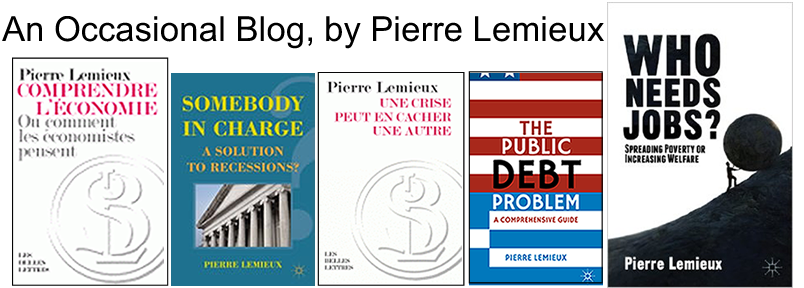Published in the Financial Post (www.nationalpost.com), January 25, 2013
In Tuesday’s Financial Times, well-known columnist Martin Wolf argues that “America’s fiscal policy is not in crisis.” “The federal government,” he writes,“is not on the verge of bankruptcy.” “This,” Wolf admits, “is a highly controversial statement.”
Indeed, many analysts believe that the U.S. federal government is bankrupt. They include, among others, economists Jeffrey Hummel of San Jose State University and Laurence Kotlikoff of Boston University. As early as 2006, Kotlikoff wrote an article in the journal of the Federal Reserve Bank of St. Louis, asking the question “Is the United States Bankrupt,” to which he answered affirmatively.
Even official government agencies such as the Congressional Budget Office (CBO) and the Government Accountability Office (GAO), which have each produced scenarios of their own, are less optimistic than the Financial Times columnist. Besides their optimistic scenarios, which they admit are themselves unsustainable, each agency produces an alternative scenario that is closer to the reality of what politicians do and have done in the past, as opposed to their perennial intentions of controlling expenditures in the future.
In reaching his rosy conclusion, Martin Wolf ignores four important issues. First, the proper horizon to consider is not 10 years but the indefinite future calculated at present value. Both the CBO and the GAO paint a quite different picture over a 25- or 75-year horizon. It is too easy to shift expenditures into the future, a favourite political pastime.
In the latest GAO outlook, for example, the optimistic scenario would, over 10 years, stabilize the federal debt held by the public at its current ratio of about 70% of GDP. However, this scenario would require a much greater effort than the January 1st fiscal cliff deal. Even if Congress ends up applying the Budget Control Act of 2011, expenditures would start growing again in 10 years and federal debt to GDP would reach about 160% of GDP in 2060. And that’s the optimistic official scenario.
Of course, the longer the forecast horizon, the higher the probability that it will be way off. But it can be way off not only on the optimistic but also on the pessimistic side (if there is a major recession or a war, for example). And we know that politicians will remain politicians.
Second, the Financial Times columnist minimizes the responsibility of the Welfare State and ignores the fact that two-thirds of the federal debt had been accumulated before the Great Recession. Between 1961 and today, the federal budget has registered only four years of surplus (the last one in 2001). As the CBO noted in its mid-2012 long-term budget outlook, “the growing debt reflects an imbalance between spending and revenues that predated the recession.”
Third, Mr. Wolf appears overly optimistic on the possibility of reducing federal expenditures. Social Security (the federal public pensions system) faces increased expenditures over the next 20 years due to population aging. Even more consequential, as Wolf notes, is the weight of federal health programs. U.S. governments, and especially the federal government, spend more on public health care (Medicare for the old, Medicaid for the poor, and CHIP for children) as a proportion of GDP than the average OECD country. The new public health insurance system, dubbed Obamacare, will likely fail at reducing the growth of these expenditures, as the CBO’s and GAO’s realistic scenarios admit.
These realistic scenarios calculate that maintaining the federal debt at 70% of GDP would (without different tax policies than those pursued in the past) require an immediate and permanent cut of about one-third in non-interest federal expenditures compared to their current trajectory. Any delay would mean still larger cuts in the future. This is a tall order.
Fourth, and as a counter-argument, Martin Wolf claims that higher tax revenues can contribute much in bridging the fiscal gap. He hints at higher taxes on the top 1% of income earners. But these people already pay 40% of federal income taxes. Moreover, it can be calculated that doubling these people’s average tax rate forever would only close half the fiscal gap, and this unrealistically assumes that they will continue to work as much and declare as much income. The CBO’s and GAO’s realistic scenario estimates that closing the fiscal gap with taxes would actually require the equivalent of increasing by 50% all federal tax rates on everybody, bringing to European levels the total tax burden in America. It is far from sure that Americans would accept this.
The CBO’s and GAO’s estimates predate the Jan. 1 fiscal cliff deal, and we will have to wait until Feb. 4 for the new CBO long-term forecasts. We already know, however, that the deal will change little. Its net tax increase covers less than 10% of the cumulative deficits of US$10-trillion that the CBO already forecasted over the coming 10 years.
The financial liabilities on the U.S. federal government’s official balance sheet are already five times the amount of its financial assets, not counting its future commitments on entitlements (Social Security, Medicare, etc.). This government is technically bankrupt. When investors realize this, a fiscal crisis will develop.
